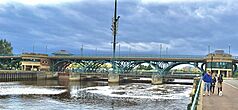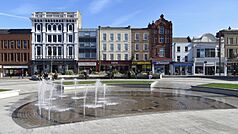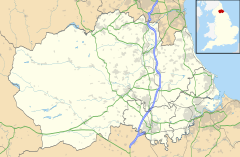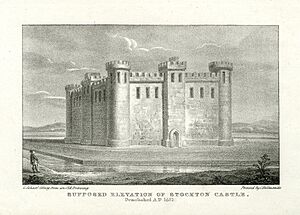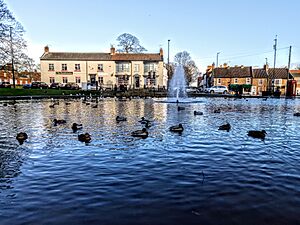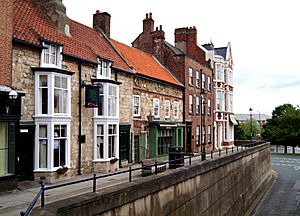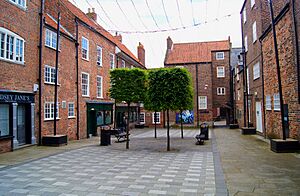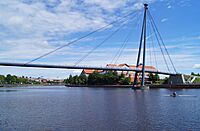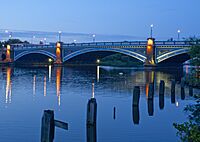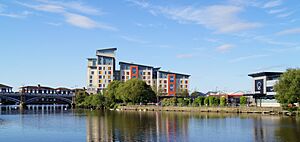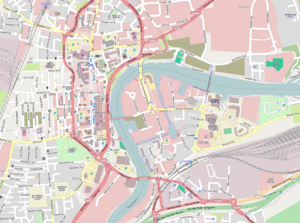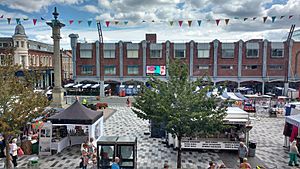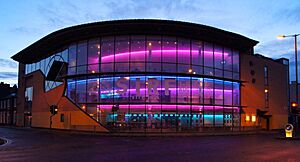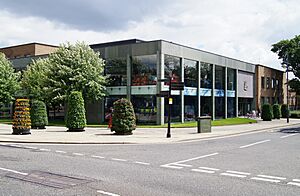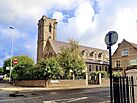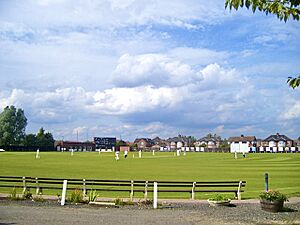Stockton-on-Tees facts for kids
Quick facts for kids Stockton-on-Tees
|
|
|---|---|
| Town | |
|
|
| Population | 84,815 |
| OS grid reference | NZ440200 |
| • London | 217 mi (349 km) |
| Unitary authority |
|
| Ceremonial county | |
| Region | |
| Country | England |
| Sovereign state | United Kingdom |
| Post town | STOCKTON-ON-TEES |
| Postcode district | TS16–TS21 |
| Dialling code | 01642 |
| Police | Durham |
| Fire | County Durham and Darlington |
| Ambulance | North East |
| EU Parliament | North East England |
| UK Parliament |
|
Stockton-on-Tees is a busy market town in County Durham, England. In 2021, its population was 84,815 people. The town is the largest part of the wider Borough of Stockton-on-Tees. It is located on the northern bank of the River Tees, as part of the Teesside area.
In the early 1800s, the River Tees was made straighter. This helped larger ships reach the town's port. Today, ships cannot sail from the sea to the town. This is because of the Tees Barrage, which helps control tidal flooding. The Stockton and Darlington Railway was important for the port during the early Industrial Revolution. This railway was also the world's first passenger railway to use steam locomotives.
Contents
History
What Does the Name Stockton Mean?
The name Stockton comes from Anglo-Saxon words. The ending ton means farm or homestead. The word Stock might come from Stocc, meaning log or wooden post. So, Stockton could mean a farm built of logs.
However, some think Stock comes from Stoc, meaning cell, monastery, or place. This suggests that Stockton might have been an outpost of important Anglo-Saxon centers like Durham or Norton. Stockton was part of Norton until 1713. Then it became its own parish. In 1913, Norton became part of Stockton.
Ancient Discoveries
Stockton is said to be where the most northern hippopotamus fossil was found. In 1958, a dig about 4 miles (6.4 km) north-west of the town found a 125,000-year-old hippo's tooth. But no one knows exactly where or how it was found. The tooth was sent to the Natural History Museum in London. Since then, it has been lost.
Early Town Life
Stockton started as an Anglo-Saxon settlement. It was built on high ground near the River Tees. By 1138, Stockton was known as a manor. In 1189, Bishop Pudsey of Durham bought it.
In the 13th century, the bishop turned Stockton into a borough. This meant it was a town with special rights. The bishop freed Stockton's serfs, who were like servants. This allowed craftsmen to move to the new town. The bishop also had a home called Stockton Castle. It was a fortified manor house. The first mention of it was in 1376.
Stockton's market began in 1310. Bishop Bek of Durham gave the town a charter for a market every Wednesday. The town became a small but busy port. It exported wool and imported wine. In the Middle Ages, Stockton was a small town with only about 1,000 people. It did not grow much for centuries.
In 1644, Scotland captured Stockton Castle. They held it until 1646. The castle was destroyed by order of Oliver Cromwell after the English Civil War. Today, a shopping center called the Castlegate Centre is on the castle's old site. This center is planned to be taken down in 2022. No accurate pictures of the castle are known to exist.
The Town House, now called the Town Hall, was built in 1735. Stockton's first theater opened in 1766. In 1771, a stone bridge with five arches was built. It replaced the Bishop's Ferry. This bridge was the lowest crossing point on the Tees until the Middlesbrough Transporter Bridge opened in 1911. By the late 1700s, the Industrial Revolution changed Stockton. It grew from a quiet market town into a busy center for heavy industry.
In 1833, Bishop William Van Mildert gave land to Stockton. This land included an old burial site. On this land, the Gothic style Holy Trinity Church was built. It was designed by John and Benjamin Green. Construction began in 1834. It became an Anglican church on December 22, 1835.
The Age of Locomotion
Shipbuilding began in Stockton in the 1400s. It grew in the 1600s and 1700s. Other smaller industries also started, like making bricks, sails, and ropes. Stockton became the main port for County Durham and other nearby areas. It exported rope, farm goods, and lead. In the 1700s, iron making and engineering also became important.
The town grew quickly as the Industrial Revolution began. The population jumped from 10,000 in 1851 to over 50,000 in 1901. This was because many workers moved there. When iron ore was found in the Eston Hills, blast furnaces were built along the River Tees. In 1820, a group called the Commissioners was set up. They were in charge of lighting and cleaning the streets. From 1822, Stockton-on-Tees was lit by gas.
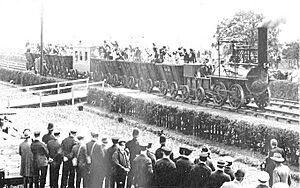
In 1822, Stockton saw a major event that changed the world. The first rail of George Stephenson's Stockton and Darlington Railway was laid. This was near St. John's crossing on Bridge Road. Locomotion No 1, driven by Stephenson himself, made its first journey on September 27, 1825. This was the world's first passenger railway. It connected Stockton with Shildon. The railway helped Stockton's economy by making it easier to bring coal to factories. However, the port became less important as business moved to Middlesbrough.
Stockton had another important invention in 1827. A local chemist named John Walker invented the friction match. He sold the first matches from his shop on High Street on April 7, 1827. Walker did not get a patent for his invention. So, he did not become famous or rich from it. He retired some years before he died in 1859 at age 78. He is buried in Norton village.
The first bell for Big Ben was made in Norton by John Warner and Sons on August 6, 1856. But it was damaged during testing. A new bell had to be made by another company closer to Westminster.
To serve the growing population, a hospital opened in Stockton in 1862. A public library opened in 1877. Public transport also became important. Steam trams started running in 1881. These were replaced by electric trams in 1897.
Stockton in the 1930s

In the 1930s, Stockton was still a center for engineering. There was also a chemicals industry. Buses replaced the trams in 1931. Public housing became necessary. In the 1930s, old, poor quality homes were removed. The first council houses were built.
On September 10, 1933, the Battle of Stockton took place. Around 200 to 300 supporters of the British Union of Fascists came to Stockton for a rally. But about 2,000 anti-fascist protesters drove them out of town.
Modern Stockton
In the late 1900s, manufacturing in Stockton greatly decreased. Service industries became the main employers.
In July 1992, there were disturbances in the Ragworth area. Local young people caused trouble. The area later had a £12 million redevelopment. This involved tearing down and fixing up homes. New houses and community buildings were also constructed.
Geography
Stockton is on the north bank of the River Tees. The town center is directly on the river. The northern and western parts of town are on slightly higher ground. Stockton sometimes has small earth tremors. For example, on January 23, 2020, there was a tremor measuring 2.8 on the Richter scale.
Stockton has many areas outside the town center. These include Fairfield, Portrack, Hardwick, Hartburn, Elm Tree Farm, Norton, Roseworth, Newtown, Bishopsgarth and Oxbridge. Norton is the second largest area in the town.
Distances to Other Places
| Place | Distance | Direction | Relation |
|---|---|---|---|
| London | 217 miles (349 km) | South | Capital city of the UK |
| Durham | 18 miles (29 km) | North | Historic county town and closest city |
| Darlington | 10 miles (16 km) | West | Nearby town in the Combined Authority area |
| Hartlepool | 9 miles (14 km) | North east | Nearby town in the Combined Authority area |
| Middlesbrough | 3 miles (4.8 km) | East | Nearby town in the Combined Authority area |
Climate in Stockton
Stockton-on-Tees has an oceanic climate, typical for the United Kingdom. It is protected by the Lake District and Pennines to the west. This makes Stockton relatively dry for the U.K., with about 25 inches (643 mm) of rain each year. Its climate is more like a continental climate than other parts of the U.K. This means it has warmer summers and colder winters. Summer highs usually reach about 20 °C (68 °F). Winter lows can drop to several degrees below 0 °C (32 °F).
| Climate data for Stockton-on-Tees (1991–2020) | |||||||||||||
|---|---|---|---|---|---|---|---|---|---|---|---|---|---|
| Month | Jan | Feb | Mar | Apr | May | Jun | Jul | Aug | Sep | Oct | Nov | Dec | Year |
| Mean daily maximum °C (°F) | 7.0 (44.6) |
7.9 (46.2) |
10.0 (50.0) |
12.8 (55.0) |
15.5 (59.9) |
18.2 (64.8) |
20.6 (69.1) |
20.4 (68.7) |
17.7 (63.9) |
13.9 (57.0) |
9.9 (49.8) |
7.3 (45.1) |
13.5 (56.3) |
| Daily mean °C (°F) | 4.1 (39.4) |
4.6 (40.3) |
6.1 (43.0) |
8.4 (47.1) |
10.8 (51.4) |
13.6 (56.5) |
15.8 (60.4) |
15.7 (60.3) |
13.3 (55.9) |
10.2 (50.4) |
6.7 (44.1) |
4.2 (39.6) |
9.5 (49.0) |
| Mean daily minimum °C (°F) | 1.1 (34.0) |
1.2 (34.2) |
2.1 (35.8) |
3.9 (39.0) |
6.1 (43.0) |
8.9 (48.0) |
10.9 (51.6) |
10.9 (51.6) |
8.8 (47.8) |
6.5 (43.7) |
3.5 (38.3) |
1.0 (33.8) |
5.4 (41.7) |
| Average precipitation mm (inches) | 40.2 (1.58) |
36.1 (1.42) |
34.0 (1.34) |
39.2 (1.54) |
42.0 (1.65) |
55.7 (2.19) |
59.1 (2.33) |
63.3 (2.49) |
52.3 (2.06) |
59.3 (2.33) |
62.8 (2.47) |
52.2 (2.06) |
596.2 (23.46) |
| Mean monthly sunshine hours | 56.1 | 76.2 | 109.6 | 138.9 | 180.7 | 171.2 | 174.3 | 161.4 | 125.9 | 91.1 | 59.5 | 50.4 | 1,395.3 |
| Source: UK Met Office | |||||||||||||
Stockton Town Centre
Stockton town center is the main part of the borough. Its High Street is one of the widest in the UK. It runs north from Bridge Road and Yarm Lane to Maxwell's Corner. The Stockton-on-Tees Town Hall, built in 1735, stands in the middle of the High Street. The Georgian-style Shambles Market Hall is also there. The largest outdoor market in North East England is held around the Town Hall every Wednesday and Saturday. This market has been around since the 1300s.
Many buildings in the town center show Georgian and late medieval styles. These listed buildings give the town its unique look. Shops often have narrow fronts but stretch far back. This style is common around the marketplace and on streets like Silver Street, Finkle Street, and Ramsgate. The ruins of the Gothic style church in Trinity Green, from 1834, also remain.
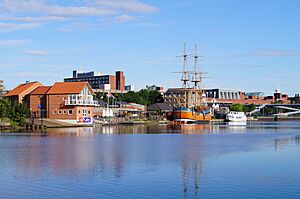
Before 2022, most shops were in two centers: Castlegate and Wellington Square. Wellington Square has open shops on pedestrian paths. The Castlegate, opened in 1972, is being taken down. It had a multi-storey car park and an indoor market. The Teesquay Millennium Footbridge connects Castlegate Quay to Teesdale Business Park and Durham University's Queen's Campus on the south side of the river. Wellington Square, opened in 2001, has 46 shops.
The town center still has old yards like Wasp Nest Yard and Ship Inn Yard. The most famous is Green Dragon Yard. It has restored historic warehouses and alleyways. This area is known as the town's cultural spot. It has the Green Dragon public house, Green Dragon Studios (for music), and Britain's oldest surviving Georgian Theatre.
Besides shops, Stockton town center also has banks, travel agents, a post office, hairdressers, cafés, and restaurants. Some old buildings have been renovated for small businesses like law firms and accountants.
Riverside Area
Since the Tees Barrage was built in 1995, the River Tees through Stockton stays at high tide. This creates a great setting for riverside events and water sports. You can enjoy rowing, canoeing, jet skiing, and dragon boat racing. Stockton town center is higher than the river. The A1305 Riverside Road, a dual carriageway, runs between them.
From the town center, streets like Bishop Street and Silver Street offer views of the river. You can see Teesdale Business Park and Durham University Queen's Campus on the other side. The skyline of Middlesbrough and Roseberry Topping in the Cleveland Hills are also visible.
Chandlers Wharf is on the north side of the river, near Victoria Bridge. This area has offices and homes. It includes the colorful Mezzino student apartments and a Mecca Bingo hall. Next to the wharf is Castlegate Quay, which was once the town's main dock. Old Georgian warehouses there are now businesses, restaurants, and a gym. A full-size replica of Captain James Cook's ship HM Bark Endeavour used to be here. The Teesside Princess, a two-deck river boat, offers cruises to Yarm.
Both sides of the Tees have footpaths along the river. The Tees Walkway on the north bank is part of the National Cycle Network.
The 11-meter Aeolian Motion wind sculpture stands on a grassy slope by the river. This area becomes an amphitheatre for big events. From Castlegate Quay, a tree-lined path leads to green space and a car park. Beyond the Princess of Wales Bridge, the River Tees Watersports Centre is located. This leads to the Tees Barrage.
Transport
Roads in Stockton
The town is served by two main roads: the A66 (east/west) and the A19 (north/south). The A19 connects Stockton to York in the south and extends to Peterlee and Sunderland in the north. East of the town center is the A1046, a dual carriageway through Portrack. This area is a major retail zone. The A139 connects the town center to Norton. This was the original route for the A19.
The A177 runs from Stockton town center to Durham. It is known as Durham Road and passes Sedgefield. It is an important route in and out of Stockton.
The A66 connects Stockton directly to Middlesbrough (8 miles (13 km) east) and Darlington (10 miles (16 km) west). Beyond Darlington is the A1(M) motorway. The A66 connects to Stockton center by the A135. The A135 is named '1825 Way' to remember the opening of the Stockton and Darlington Railway.
Many bus services operate in Stockton. Most pass through the High Street. These services cover large areas, including Middlesbrough, Teesside Park, Thornaby-on-Tees, Billingham, Sedgefield, Durham, Sunderland, Peterlee, and Newcastle upon Tyne. Stagecoach on Teesside and Arriva North East are the main bus companies.
Rail Travel
The Stockton-on-Tees train station is located above the High Street. However, more frequent and long-distance trains run from nearby Thornaby.
Northern operates local and regional services at both stations. At Thornaby, TransPennine Express runs an hourly service between Saltburn-by-the-Sea and Manchester Airport. LNER also stops once each way every weekday between Middlesbrough and London King's Cross.
Air Travel
Teesside International Airport is partly located within the borough. It is several miles west of the town. The airport offers domestic flights and international flights, especially to destinations in the EU.
Economy
Stockton is famous for being the home of the friction match. It is also known for the Stockton and Darlington Railway. This railway ran the world's first steam-hauled passenger train in 1825. The town also has the world's oldest passenger railway station building. For many years, industry and engineering were key to Stockton's economy. Major industries included shipbuilding, heavy engineering, steel, and chemicals manufacturing. However, in the 20th century, heavy industry in Teesside greatly declined.
Recent Developments
Since the 1980s, Stockton has seen more service industries. The Teesdale Business Park was built on the south bank of the River Tees. This created office space for many large service companies. They opened call centres and offices there. Durham University's Queen's Campus is also in the Teesdale development. It is connected to the town center by several bridges.
In 1995, the Tees Barrage was completed after four years of building. It keeps the river waters upstream at a constant high tide level.
In 2007, funding helped save the ruins of the Holy Trinity Church. The site was renovated into Trinity Green. This removed it from the 'Heritage at Risk Register'.
Future Plans
Work is happening to develop the north bank of the River Tees in Stockton. This £300 million Northshore project will include new offices, leisure facilities, homes, a hotel, and a new campus for Durham University.
In 2012, a long-term plan was announced to improve the town center. This plan involves about £38 million in investment. The goal is to attract more shops, businesses, and shoppers. It will create new spaces and links to the River Tees. It will also make access and parking easier.
Plans include a large plaza called 'Infinity View'. This will offer great views of the Infinity Bridge. The banks of the River Tees will also get impressive light displays. These lights will stretch along the waterfront. This permanent lighting is meant to help riverside businesses and add to the council's events.
Stockton is one of 12 towns in England to get funding and support from retail expert Mary Portas. Stockton's Town Team will get advice from retail experts.
The Stockton-Middlesbrough Initiative is a 20-year plan. It aims to improve the urban core of the Tees Valley. The main focus is the 30 square kilometers along the banks of the River Tees. This area is between Stockton and Middlesbrough. The plan aims to bring high-quality city-like features to the Tees Valley. This includes the town centers of Stockton and Middlesbrough.
In February 2020, it was announced that the Castlegate Shopping Centre would be taken down in 2022.
Demographics
In the 2021 census, the borough of Stockton had a population of 196,595. About 50.9% of the population were female.
For religion, 51.1% identified as Christian. 39.1% said they had no religion. Other religions included Muslim (3.4%), Hindu (0.4%), Sikh (0.4%), and Buddhist (0.3%).
For ethnicity, 92.0% identified as White. Asian, Asian British or Asian Welsh people made up 4.6%. Black, Black British, Black Welsh, Caribbean or African people were 1.1%. Mixed or 'Multiple ethnic groups' were 1.4%.
| Sex | ||
|---|---|---|
| 2021 Census | Count | % |
| All usual residents | 196,595 | 100.0 |
| Female | 100,072 | 50.9 |
| Male | 96,523 | 49.1 |
| Ethnicity | ||
|---|---|---|
| 2021 Census | count | % |
| All usual residents | 196,593 | 100.0 |
| Asian, Asian British or Asian Welsh | 9,052 | 4.6 |
| Black, Black British, Black Welsh, Caribbean or African | 2,203 | 1.1 |
| Mixed or Multiple ethnic groups | 2,737 | 1.4 |
| White | 180,937 | 92.0 |
| Other ethnic group | 1,664 | 0.8 |
| Religion | ||
|---|---|---|
| 2021 Census | count | % |
| All usual residents | 196,595 | 100.0 |
| No religion | 76,840 | 39.1 |
| Christian | 100,420 | 51.1 |
| Buddhist | 532 | 0.3 |
| Hindu | 811 | 0.4 |
| Jewish | 61 | 0.0 |
| Muslim | 6,675 | 3.4 |
| Sikh | 782 | 0.4 |
| Other religion | 550 | 0.3 |
| Not answered | 9,924 | 5.0 |
Festivals and Fairs
Stockton Calling is a music festival held every Easter Sunday. It started in 2010 and takes place in several music venues. In 2019, Sophie and the Giants were a main act.
The Stockton International Riverside Festival (SIRF) is one of Europe's largest outdoor festivals. It happens once a year since 1988. Over a long weekend, it attracts more than 250,000 visitors. It features circus acts, comedy, music, dance, and street theater.
The annual riverside firework display is held on the first Sunday near November 5. Up to 100,000 people from the region usually attend. The year's events end with the Stockton Sparkles Christmas festival and markets.
Theatres and Music Venues
The ARC Theatre & Arts Centre on Dovecot Street opened in 1999. It is a multi-purpose arts center for cinema, theater, dance, and music. It has a 260-seat theater, a 100-seat studio theater, a music area for 550 standing people, and a 130-seat cinema. It also has exhibition spaces, meeting rooms, a café, and two bars.
The Georgian Theatre at Green Dragon Yard is a Grade II listed building. It is the oldest Georgian theater in the country. It first opened in 1766. It was later a sweet factory and then a community building. Between 2007 and 2008, the building was fully renovated. It now hosts live entertainment for up to 200 people.
The Grade-II listed Globe Theatre was built in 1936. It is at the north-western end of the High Street. The theater reopened in 2021 after a big restoration. It was built on the site of two earlier theaters. Many famous acts have performed there, including Buddy Holly, the Rolling Stones, The Beatles, and Chuck Berry. The Beatles famously played the Globe on November 22, 1963, the day U.S. President John F. Kennedy was assassinated.
Public Art
Stockton Flyer
On June 12, 2016, Stockton Council launched The Stockton Flyer. This is a model of a flying steam locomotive on a stand on Stockton High Street. The Flyer was unveiled to celebrate Queen Elizabeth II's 90th birthday. The Stockton Flyer appears from its stand every day at 1 p.m. Many people gather to watch it rise and lower.
Aeolian Motion
The wind sculpture Aeolian Motion was designed by Phil Johnson. It was built at the end of Silver Street in March and April 2001. The design is meant to give the seating area a unique look. It reflects Stockton's character and creates a sense of place.
Facilities
Stockton offers many public services. These include a general hospital, health advice centers, dental and medical surgeries, a library, churches, and employment advice centers. There are also youth projects and an international family center. Many public buildings are on Church Road. The police headquarters is in the center, next to Stockton Central Library.
The University Hospital of North Tees is in the town. It serves south-east County Durham. It is part of the North Tees and Hartlepool NHS Trust.
Public Parks
Stockton has several public parks and nature reserves. The most notable is Ropner Park. This is a Victorian-style park on the edge of town, near Hartburn village. It opened in 1893 and was renovated in 2007. The park has tree-lined paths leading to a fancy water fountain. There are also rockeries and flower displays. A bandstand overlooks a lake, with live band music on summer Sunday afternoons. The park also hosts seasonal fairs and events. Nearby is Trinity Green, a smaller park with the ruins of the Holy Trinity Church.
Further up the river is Preston Park. This is a 100-acre (40 ha) public park by the River Tees. The park hosts many events each year. Preston Hall, once the home of Sir Robert Ropner, is inside the park and is now a museum. The park also has 'Butterfly World'. This is a tropical environment with different kinds of exotic butterflies and reptiles.
Downstream is Portrack Marsh Nature Reserve. This 50-acre (20 ha) nature reserve is on the northern bank of the river. It is between the Tees Barrage and the Tees Viaduct. It is the last remaining wetland on the lower Tees. The Tees Valley Wildlife Trust manages the reserve.
Leisure Activities
The town's main leisure facility is 'Splash'. This large center on Church Road has both wet and dry areas. It includes a 25m pool with a wave machine and flumes. There is also a learner pool, a spa pool, a two-story fitness area, and spaces for various activities. The Castlegate Quay Watersports Centre offers opportunities for sailing and paddling on the River Tees.
Libraries
Stockton Central Library on Church Road is the largest public library in the borough. Built in 1967, it was fully renovated in 2011. The ground floor has the Customer Services Centre, an adult lending library, and a children's library. The first floor has the reference library, a family history area, a computer suite with free internet, and a café. The library also has meeting rooms and an exhibition area.
Religion
Stockton is part of the Church of England's Diocese of Durham. The churches of St Peter, Stockton Parish Church (St Thomas'), and St Paul are in the town. Holy Trinity Church was built as an Anglican church. It later became Greek Orthodox and was destroyed by fire in 1991. Its ruins remain today.
Stockton is also in the Roman Catholic Diocese of Hexham and Newcastle. It has parishes like St Bede, St Cuthbert, English Martyrs and SS Peter and Paul, St Joseph, St Mary, and St Patrick.
Stockton has a notable Muslim population of 6,675 people. Mosques like Farooq E Azam Mosque and Islamic Centre serve this community. The Farooq E Azam mosque is the first in the North-East of England to be allowed to play the call to prayer, or Adhan, once a week at an agreed volume.
Sport
Stockton Cricket Club was started in 1816. Since 1891, it has been at the Grangefield Cricket Ground. The club has three senior teams that play in the Dukes North East Premier League.
Stockton Football Club existed from 1882 until 1975. They played at the Victoria Ground. This ground also hosted greyhound racing. The club's assets were given to Norton Cricket Club. They then started the Norton & Stockton Ancients Football Club.
There are two other football clubs in town. Stockton Town F.C. plays in the Northern Premier League Premier Division. They have moved up through leagues, including winning the Wearside League in 2016. In May 2024, they were promoted to Step 3 after a Play Off win. Meanwhile, Stockton West End plays in the North Riding Football League Premier Division.
Stockton Rugby Club was established in 1873. It is the local Rugby Union team. Home games are now played at the Grangefield Ground. This is thanks to a partnership with Stockton Cricket club and Grangefield Academy.
Notable People
People born in Stockton include:
- Jamie Bell, actor
- Lee Cattermole, footballer
- Ivy Close, actress
- Lesley Duncan, pop singer-songwriter
- Will Hay, comic actor
- Richard Kilty, sprinter
- Jordan Nobbs, footballer
- Geoff Parling, England and British and Irish Lions rugby player
- Luke Pearson, cartoonist
- Franc Roddam, film director/producer
- Graham Rowntree, England rugby player
- Thomas Sheraton, furniture designer
- Paul Smith, singer in rock band Maxïmo Park
- Jeremy Swift, actor
- Stephen Tompkinson, actor
- John Walker, inventor of the friction match
Other notable residents include:
- Duncan Bannatyne, entrepreneur, moved to Stockton when he was 30.
- Harold Macmillan, former Prime Minister, was an MP for Stockton.
- Michael Marks, founder of Marks & Spencer, started his business career in Stockton.
- George Orwell, author, lived near Carlton, a village in the borough.
- Ridley Scott and Tony Scott, film directors, both lived in Stockton when they were young.
See also
 In Spanish: Stockton-on-Tees para niños
In Spanish: Stockton-on-Tees para niños




